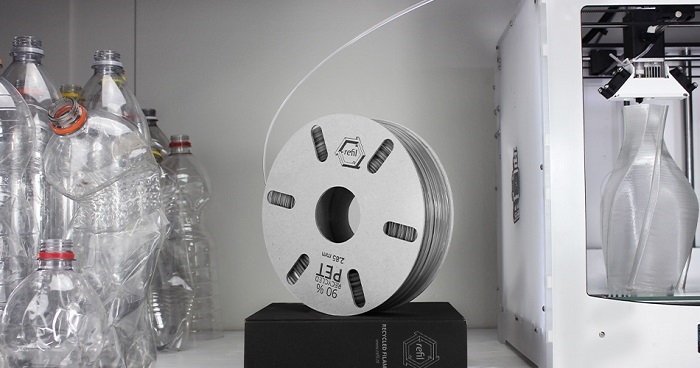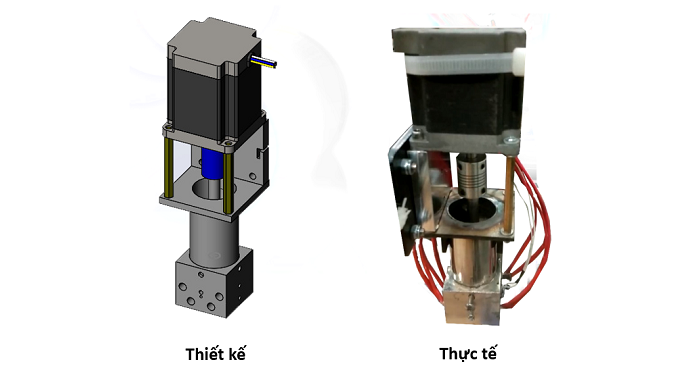To take advantage of 3D printing technology, amateur inventors in Ho Chi Minh City Thu Duc has improved popular 3D printers into machines that can directly recycle PET and PP plastic.

Replacing virgin plastic with recycled plastic
In recent years, 3D printing technology has brought a lot of hope to both the manufacturing industry and the environment. 3D printing not only makes it possible to create amazing products quickly and accurately, but it can also positively impact the environment by reducing excess material when making products, eliminating transportation costs ( because all the parts can work in one place) and recycle materials.
A long-term goal in the 3D printing community is to recycle plastic. Because 3D printers use "ink filaments" made of thermoplastics, it is theoretically possible to reuse much of the plastic to prevent it from accumulating in landfills. But in reality, this is not easy.
Most 3D printers currently use virgin resin filaments from acrylonitrile butadiene styrene (ABS) and polylactic acid (PLA) to ensure flexibility and uniformity. These two types of plastic are both plastic number 7 in the international plastic identification code and are not normally recycled in the recycling programs of the countries.
Other plastics, such as polyethylene perephthalate (PET), polyethylene (PE), polypropylene (PP) and nylon can also be used for 3D printing, but are rarely used because they require specialized equipment and processing methods. more usable and may produce undesirable print characteristics. In addition, some plastics, such as polyvinyl chloride (PVC) may not be suitable for 3D printing due to the release of harmful gases when melted.
There are many types of 3D printers on the market from plastic filaments, but there are almost no printers that use recycled plastic. In 2020, Mr. Nguyen Tien Uoc (Thu Duc City) and two students Nguyen Quoc Thinh and Vo Hoang Duy (HCMC University of Technical Education) were tired of using raw plastic "ink filaments" of plastic. expensive up to 250,000-300,000 VND/kg. So they built a machine that can print directly with plastic waste – such as soft drink bottles (PET) or textiles, medical masks (PP plastic). These two types of plastic account for nearly 40% of plastic waste today.
“The design is very simple. Just replacing a few plastic extrusion parts can turn an ordinary printer into a recycled plastic printer, "said Nguyen Tien Uoc.
To make the most of plastic bottles, they cut them into 2-3 cm pieces and put them in an automatic plastic feeder. The resin passes through the extruder and the melt is controlled by an open source device they designed themselves to get down to the printhead. Finally, the plastic is extruded and deposited layer by layer on a board like any 3D printer.

Although PET or PP plastic is a bit of a challenge for 3D printing, thanks to great advice from experts in polymer materials research at Hanoi University of Science and Technology, the group of young people has created a strong connection. harmonize between nozzle temperature and resin cooling rate. Once they've mastered the know-how, they have the power to unlock a near-limitless (and free) supply of recycled 3D-printed materials.
Of course, 3D printers from recycled plastic are currently still in low resolution mode and the product quality is not so exquisite, but it is an extremely impressive first step in solving the big economic problem. economy and environment. Recycled plastic materials will reduce input costs by 5-10 times compared to the current one.
Anh Uoc said that they are ready to transfer the right to use and transfer all of these designs to communities and social organizations in need. Schools or Fab Labs with 3D printers can then collect plastic bottles on-site and turn them into useful products – such as teaching aids or prosthetics to help disabled people integrate into life.
Replace natural wood with recycled plastic
Not stopping at recycled plastic, Mr. Uoc's team even went further in experimenting with mixing recycled plastic with other solid waste.
They tried to consider mixing PET plastic with common construction wastes such as stone powder, bricks, cement, concrete, and sand to create 3D printed products. Some become harder and stronger, others become brittle and break easily. There are a wide variety of formulations available to create possible particles with different quality requirements.
But the most surprising thing was when they tried to mix PP with wood pulp and sawdust. The results show that it is possible to replace up to 30-50% of natural wood materials with recycled plastic and still create 3D printed products with great mechanical strength. According to Mr. Nguyen Tien Uoc, this result opens up many opportunities to create products of both economic value and high aesthetic value such as furniture, wooden statues, and jewelry.
The demand for wooden furniture is always high, but in nature, wood is being over-exploited and the waste of the wood industry is mainly used as fuel. Therefore, the recycling of "wood-plastic" materials will help solve the input problem for many factories looking for sustainable solutions to replace natural wood. What's more, with 3D printing technology, one can create any unique designs that interior designers are interested in.
Of course, PP plastic is not easy to recycle and it can cause warping. When mixed with wood pulp, other organic materials are also needed to form a cohesive glue. The cellular structure of the wood also affects the shape the wood will deform as it dries.
Mr. Uoc's team currently does not have many long-term comparative tests to confirm the usefulness of the product. Therefore, to further develop this new material, he thinks they need to work with many businesses and experts to discover more ways to control structure and mix materials.